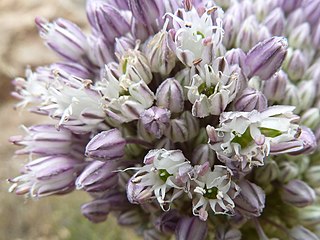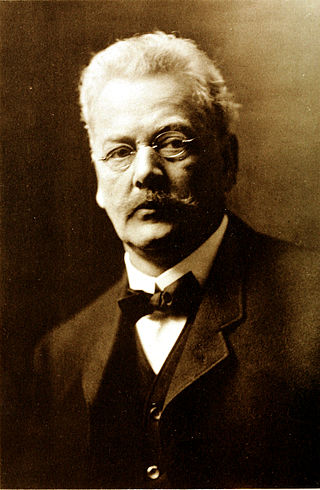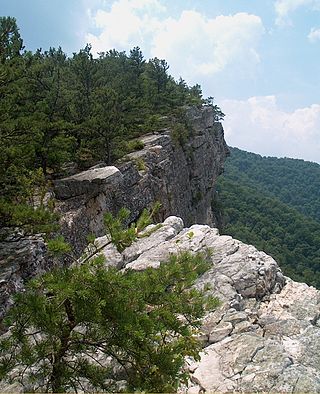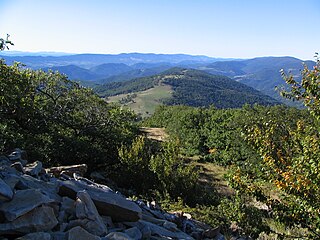
James Ewell Brown "Jeb" Stuart was a United States Army officer from Virginia who became a Confederate States Army general during the American Civil War. He was known to his friends as "Jeb,” from the initials of his given names. Stuart was a cavalry commander known for his mastery of reconnaissance and the use of cavalry in support of offensive operations. While he cultivated a cavalier image, his serious work made him the trusted eyes and ears of Robert E. Lee's army and inspired Southern morale.

The Ohio River is a 981-mile (1,579 km) long river in the United States. It is located at the boundary of the Midwestern and Southern United States, flowing southwesterly from western Pennsylvania to its mouth on the Mississippi River at the southern tip of Illinois. It is the third largest river by discharge volume in the United States and the largest tributary by volume of the north-south flowing Mississippi River that divides the eastern from western United States. It is also the 6th oldest river on the North American continent. The river flows through or along the border of six states, and its drainage basin includes parts of 14 states. Through its largest tributary, the Tennessee River, the basin includes several states of the southeastern U.S. It is the source of drinking water for five million people.

Trillium is a genus of about fifty flowering plant species in the family Melanthiaceae. Trillium species are native to temperate regions of North America and Asia, with the greatest diversity of species found in the southern Appalachian Mountains in the southeastern United States.

West Virginia is a state in the Appalachian, Mid-Atlantic and Southeastern regions of the United States. It is bordered by Pennsylvania to the north and east, Maryland to the east and northeast, Virginia to the southeast, Kentucky to the southwest, and Ohio to the northwest. West Virginia is the 10th-smallest state by area and ranks as the 12th-least populous state, with a population of 1,793,716 residents. The capital and largest city is Charleston.

The Appalachian Mountains, often called the Appalachians,, are a system of mountains in eastern to northeastern North America. The Appalachians first formed roughly 480 million years ago during the Ordovician Period. They once reached elevations similar to those of the Alps and the Rocky Mountains before experiencing natural erosion. The Appalachian chain is a barrier to east–west travel, as it forms a series of alternating ridgelines and valleys oriented in opposition to most highways and railroads running east–west.

Tidewater refers to the north Atlantic coastal plain region of the United States of America.

The Blue Ridge Mountains are a physiographic province of the larger Appalachian Mountains range. The mountain range is located in the Eastern United States, and extends 550 miles southwest from southern Pennsylvania through Maryland, West Virginia, Virginia, North Carolina, South Carolina, Tennessee, and Georgia. This province consists of northern and southern physiographic regions, which divide near the Roanoke River gap. To the west of the Blue Ridge, between it and the bulk of the Appalachians, lies the Great Appalachian Valley, bordered on the west by the Ridge and Valley province of the Appalachian range.

The New River is a river which flows through the U.S. states of North Carolina, Virginia, and West Virginia before joining with the Gauley River to form the Kanawha River at the town of Gauley Bridge, West Virginia. Part of the Ohio River watershed, it is about 360 miles (580 km) long.

Allium tricoccum is a North American species of wild onion or garlic widespread across eastern Canada and the eastern United States. Many of the common English names for this plant are also used for other Allium species, particularly the similar Allium ursinum, which is native to Europe and Asia.

Nathaniel Lord Britton was an American botanist and taxonomist who co-founded the New York Botanical Garden in the Bronx, New York.

Allium ampeloprasum is a member of the onion genus Allium. The wild plant is commonly known as wild leek or broadleaf wild leek. Its native range is southern Europe to western Asia, but it is cultivated in many other places and has become naturalized in many countries.

Charles Frederick Millspaugh was an American botanist and physician, born at Ithaca, N.Y., and educated at Cornell and the New York Homeopathic Medical College. He received his medical degree in 1881 and practiced medicine in Binghamton, New York until 1890. From 1891 to 1892, he taught botany at West Virginia University. In 1894 he was appointed as the newly established Field Museum of Natural History's first Curator of Botany, a position he held until his death. From 1897 to 1923 he was also professor of medical botany at the Chicago Homeopathic Medical College and lectured on botany at the University of Chicago. Millspaugh conducted explorations in the United States and Mexico, the West Indies, Brazil, and other parts of South America, and was the author of American Medical Plants (1887); Flora of West Virginia (1896); Contribution I-III to the Coastal and Plain Flora of Yucatan (1895-1898); "Flora of Santa Carolina Island" (1923); and many articles in scientific and popular journals. He was a skilled scientific illustrator and artist, producing the majority of the illustrations for his publications."

North Fork Mountain is a quartzite-capped mountain ridge in the Ridge and Valley physiographic province of the Allegheny Mountains of eastern West Virginia. Kile Knob, at 4,588 feet, is the mountain's highest point, and Panther Knob and Pike Knob are nearly as high.

William Gay Brown Jr. was a lawyer, and Democratic politician from West Virginia who served as a United States representative. Congressman Brown was born in Kingwood, West Virginia in Preston County on April 7, 1856. He served as a member of the 62nd, 63rd, and 64th United States Congresses. He died in office on March 9, 1916.

Green Bottom Wildlife Management Area is located on former plantation lands of U.S. Congressman and Confederate General Albert G. Jenkins. The 1,096 acres (444 ha) in Cabell County and Mason County are located along the banks of the Ohio River about 16 miles (26 km) north of Huntington, West Virginia. The Green Bottom WMA land is a mixture of farmland, mixed hardwood forest, wetlands, and open water. The Jenkins Plantation Museum is located on Corps of Engineers land adjacent to the WMA. The museum is located in the original 1835 Green Bottom Plantation House, and is operated by the West Virginia Division of Culture and History.

Big Schloss is a peak in the Great North Mountain range of the Ridge and Valley Appalachians, with an elevation of 2,964 feet (903 m). The peak is located in George Washington National Forest on the border of Virginia and West Virginia, though according to Topozone, the actual summit is in Virginia. The trail is part of the Lee Ranger District. It features a rocky outcropping of white sandstone with expansive views into Trout Run Valley in West Virginia and Little Schloss Mountain in Virginia.

The Roaring Plains West Wilderness is a U.S. Wilderness Area in the Allegheny Mountains of eastern West Virginia, USA. It is part of the Monongahela National Forest and includes Mount Porte Crayon, the sixth highest point in the state.

Earl Lemley Core was a botanist and botanical educator, researcher, and author as well as a local West Virginia historian. He was founder of the Southern Appalachian Botanical Club and editor of its journal, Castanea, for thirty-five years. He was a teacher and professor at West Virginia University (WVU) from 1928 to 1972. He served for four years on the Morgantown City Council, and served as mayor of Morgantown for two years. The Earl L. Core Arboretum at WVU was named in his honor in 1967.

Symphyotrichum pilosum is a perennial, herbaceous, flowering plant in the Asteraceae family native to central and eastern North America. It is commonly called hairy white oldfield aster, frost aster, white heath aster, heath aster, hairy aster, common old field aster, old field aster, or steelweed. It may reach 20 to 120 centimeters tall, and its flowers have white ray florets and yellow disk florets.
Flora Lonette Davis Crittenden was an American educator and civil rights activist in Virginia turned politician. She worked as a teacher and guidance counselor in Newport News, Virginia public schools for 32 years, then in 1986 was elected to the Newport News City Council where she served for four years. In 1993 she was elected a member of the Virginia House of Delegates from Newport News, Virginia, and served for eleven years. In 2000, she became chair of the board of Christopher Newport University. A science and math magnet middle school in Newport News is named for her.





















